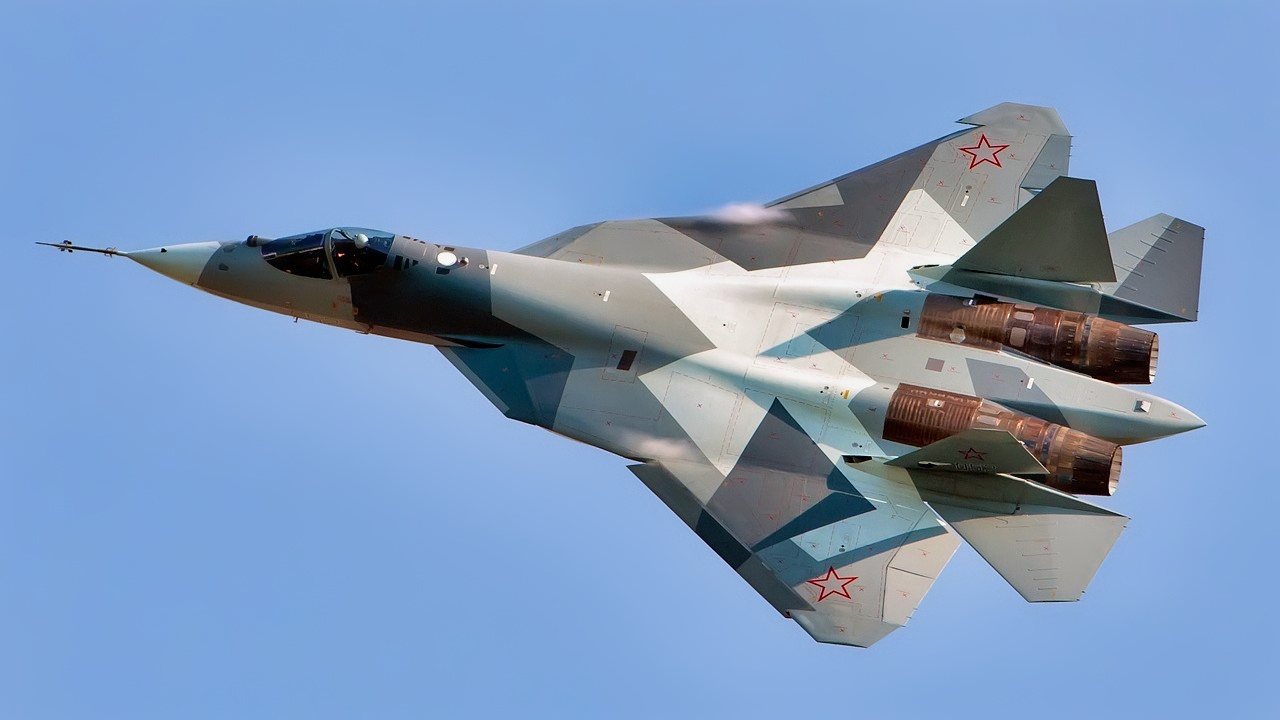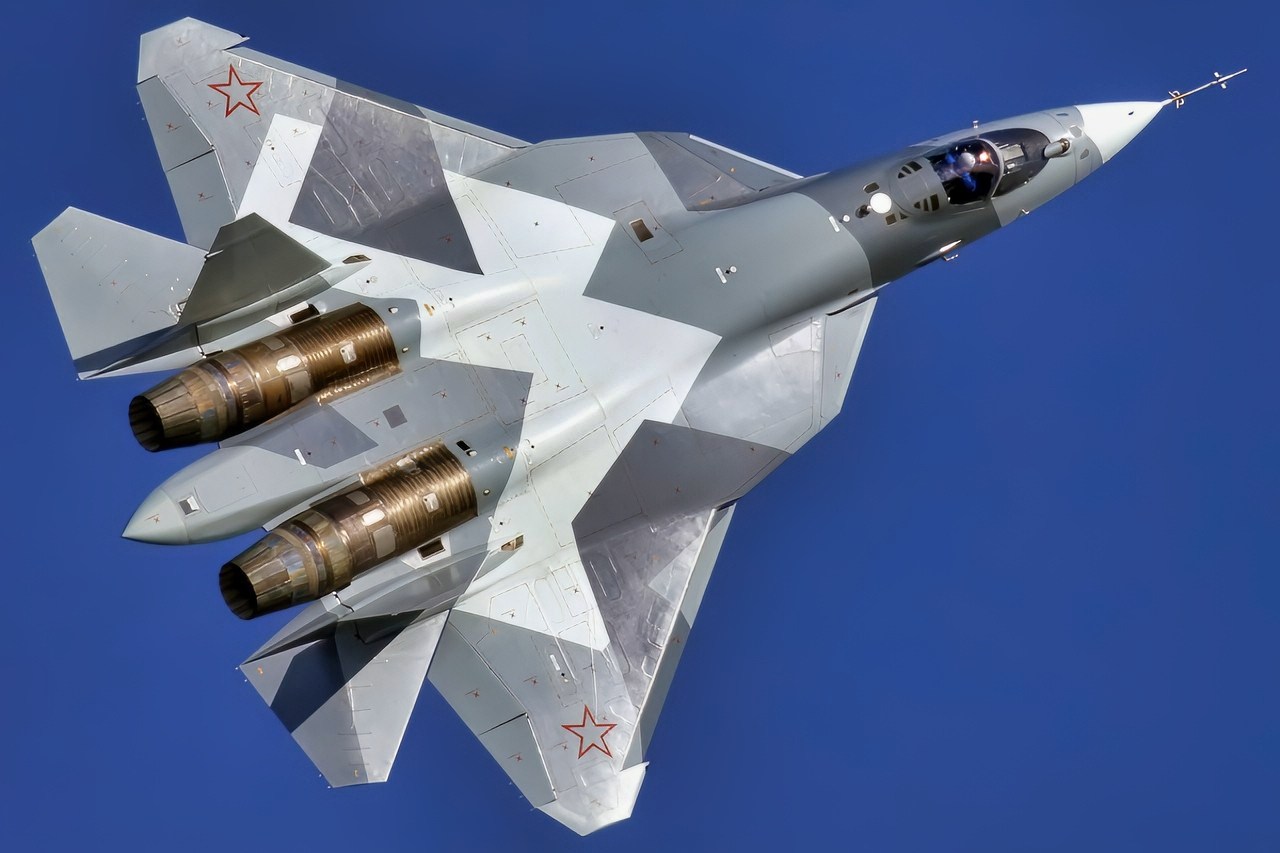Key Points and Summary – Russia’s Su-57 “Felon” evolved from the Su-27 airframe as a “cheaper and easier” path to a 5th-generation fighter, rather than a “clean sheet” design.
-This cost-driven decision has resulted in a compromised aircraft. Plagued by delays, the Su-57 is struggling with a lack of foreign investment, a problem Russia is now trying to solve by aggressively marketing the jet to India and Algeria.

Su-57 Felon Fighter Russian Ministry of Defense Photo

Russia PAK-FA or Su-57 Felon. Image Credit: Creative Commons.
-In a recent, likely sales-driven PR move, Russia revealed the jet’s internal weapons bays for the first time, attempting to showcase the program’s maturity as it seeks the cash needed to continue.
Russia’s Su-57 Felon Failure Is Now Clear
Last month, the Ukrainian media outlet United 24 Media reported that Russia was “dangling” its 84 Su-57 fighter jets, and that India may be interested in buying them.
Citing reporting from both countries, Defense Express and Indian Defence News, India was reviewing Russia’s proposals.
“Two squadrons would be delivered directly from Russian production lines, while an additional three to five squadrons could be assembled locally in India,” the United 24 story reported. Russia has also, per the report, promised “extensive technology transfers.”
Russia has also, per that report, “indicated readiness to integrate India’s domestic missile arsenal into the Su-57 platform.”
The India Deal
Should the deal go through, it would represent a shift, as India exited a joint Su-57 development program seven years ago, citing “doubts about the jet’s fifth-generation capabilities.”
The Indian publication The Print reported that India was taking “another look” at the Russian jet, although not for its stealth capabilities.
“In a twist of strategic irony, India, which withdrew from the Fifth Generation Fighter Aircraft (FGFA) programme with Russia in 2018 over concerns about the Su-57’s underwhelming stealth and super cruise capabilities, is now looking at acquiring the same aircraft,” The Print said.

Su-57 Felon Stealth Fighter Taking Off. Image Credit: Creative Commons.
That report added that under the proposed terms of the deal, Hindustan Aeronautics Limited (HAL) would join with Russia’s Sukhoi Bureau to make the aircraft in India. This would take place separately from work on India’s Advanced Medium Combat Aircraft (AMCA) program, India’s bid for a stealth fighter.
The United 24 story added that the retirement of MiG-21 fighters leaves a gap in India’s fleet.
“The Sukhoi Bureau already has a working relationship with HAL,” a source told The Print. “The Su-57 will make it easier.”
Other sources for the story looked at the bigger picture.
“To secure its airpower dominance, India as a country must accelerate AMCA Development with increased investment and streamlined processes which are critical to bringing the AMCA online before 2035,” a source said, adding that the country should also look into sixth-generation partnerships.
Algeria, Too?
Meanwhile, The National Interest reported earlier this month, citing leaked documents, that Algeria has agreed to buy more Su-57 fighter jets from Russia. The Algerian Air Force, the report said, has traditionally relied on aircraft from Russia and the Soviet Union before it.
“Russia’s United Aircraft Corporation (UAC), a subsidiary of the state-owned military industrial conglomerate Rostec, had announced last year that it would significantly increase production of its fifth-generation Sukhoi Su-57 (NATO reporting name “Felon“) multirole fighter,” the report said, adding that Russia has also been seeking foreign buyers from some of them.
The deal was revealed through a hack by the pro-Ukraine firm known as Black Mirror. The same hack, known as “Rostec,” had revealed Russia’s plans to sell MiG-29 and Sukhoi Su-35 fighter jets to Iran.
“Algiers could turn to Moscow for additional Su-30s and perhaps Sukhoi Su-35 Super Flankers to bolster its military aerial capabilities,” the report said. “This is especially relevant as Morocco, Algeria’s neighbor and perennial regional rival, has expressed interest in the US-made Lockheed Martin F-35 Lightning II.”
The Weapon Bay
This week, Defence Blog published a rare look at the Su-57’s weapons bay, based on photos that appeared on pro-Kremlin social media channels. However, the origin and timing of the images remain mysterious. And according to the report, the reveal seems timed to coincide with the upcoming export efforts.
“In addition to internal mounts, the Su-57 also includes external hardpoints beneath its wings, enabling it to carry additional guided bombs, cruise missiles, or air-to-air weapons,” the Defence Blog reported. “However, the use of external pylons compromises the aircraft’s radar cross-section—something the internal bays are specifically intended to minimize.”
As analyzed by The Aviationist, the exposed weapons bay “appears to show two weapons stations, which can hold either two air-to-air or air-to-ground weapons. Another similar weapon bay lies ahead, between the air intakes, and two side bays are near the wing’s root.”
The weapons bays, the Defense Blog report said, have traditionally been closed when the Su-57 has been displayed at air shows, other public events, and in media releases.
The report stated that the program is both “technically in serial production” and incomplete. Defence Blog also cited Russian-language posts this week stating that Russia “urgently needs foreign investment to continue the program, which has faced delays and budget constraints since its early stages.”
In addition to the export efforts, per the story, the timing seems geared towards “a renewed public relations campaign by Moscow to shape perceptions of the Su-57’s maturity.”
Why the Su-27 “Evolved” into the Su-57
This week, the Aviation Geek Club looked into how the Su-57 came about, and “evolved” from the previous Su-27.
“Noteworthy [is that] the configuration of the Sukhoi Su-57 Felon is an evolution of the Su-27’s shape adapted for the requirements of low visibility and supersonic speed and agility,” the piece said.
However, it hasn’t always been an easy road for the jet.
The fighter that NATO calls “the Felon” has suffered “development delays, a crash in 2019 and has contributed little to Russia’s invasion of Ukraine. According to its manufacturer, serial production of the aircraft began in 2022.”
Damien Leimbach, a former US Air Force (USAF) U-2 Aviation Technician, recently answered questions about the jet on Quora.
Asked why Russia opted not to develop a “clean sheet” aircraft, rather than let it evolve from its predecessor, Leimbach answered, “For the same reason they were the only country to build graphite moderated reactors without containment buildings.”
“It’s cheaper and easier. In the 1960’s all the cool kids had nuclear reactors, so the USSR had to rush one into operation so they could boast about how awesome they are. It was a matter of national pride,” he said.
It was ultimately, though, about Russia doing it on the cheap.
‘Sukhoi proposed something that could be done quickly and, in a hurry,” the technician wrote.
“Because they were essentially starting with the Su-27 frame (currently in production as the Su-35), they made the needed changes to the wings, tail, and other subframes, like filling in the gap between engine nacelles to form an internal weapons bay.”
About the Author: Stephen Silver
Stephen Silver is an award-winning journalist, essayist, and film critic, and contributor to the Philadelphia Inquirer, the Jewish Telegraphic Agency, Broad Street Review, and Splice Today. The co-founder of the Philadelphia Film Critics Circle, Stephen lives in suburban Philadelphia with his wife and two sons. For over a decade, Stephen has authored thousands of articles that focus on politics, national security, technology, and the economy. Follow him on X (formerly Twitter) at @StephenSilver, and subscribe to his Substack newsletter.
More Military
Nimitz-Class Aircraft Carrier USS Carl Vinson Has a Message for the U.S. Navy
The Navy’s New DDG(X) Destroyer Looks Like a Missile and Laser Machine
Germany’s Big F-35 Fighter Purchase Comes Down to 1 Word
Eurofighter Typhoon vs. JAS 39 Gripen E: Who Wins Summed up in 4 Words
JAS 39 Gripen E vs. Dassault Rafale Fighter: Who Wins in a Fight Summed Up in 4 Words










